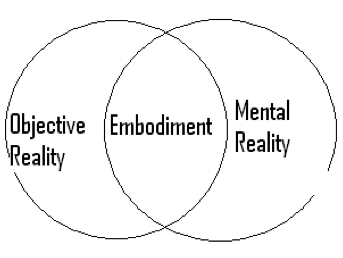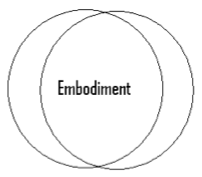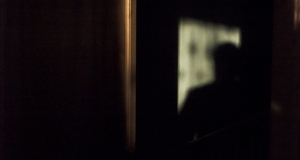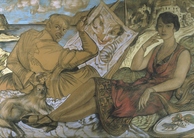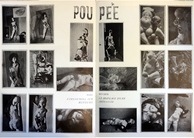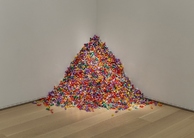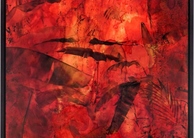From Discussions VOL. 4 NO. 1Art, Hallucination, and EmbodimentPart Three: A Model of PerceptionEmbodiment, as defined in the field of Cognitive Science, is the theory that human cognition is largely influenced by how the body interacts with the world. Thought is constrained based upon how the body is able to manipulate physical reality. Followers of the embodiment paradigm hold that cognition is always embodied. Our interaction with the world completely shapes our cognitive patterns, thus no thought may exist outside of the embodied realm. That is not to say that all thoughts have to do with how the body can interact with the world, but the mind has developed in a body, therefore all thoughts have arisen from a mind that can only function in relation to the body and how it can interact with the world. An example of embodied cognition would be looking at a hammer and thinking about the hammer in terms of its function; I can swing the hammer, hold the hammer, and pound with the hammer, all these aspects have to do with how my body can manipulate the hammer.30 Ultimately, during a hallucination as well as abstract art viewing, the world is increasingly perceived in terms of meanings arising from an embodied mind. The ven diagram model in Figure 2 models this process. Objective Reality consists of elements that exist in physical reality that are an agreed upon norm. Mental reality consists of all the workings of the mind. The degree of overlap (embodiment) determines the extent to which the environment will be perceived in terms of the meanings concocted by the mind. In this model, the amount of overlap can be modulated in two ways. First, it can occur naturally by assigning meaning to the external world. The more meanings assigned, the greater the overlap that occurs. Thus, perception will increasingly become driven by the meanings assigned to an object, as in the case of interpreting abstract art. The more meanings are assigned to an art piece results in a perception that is more based upon higher order thinking than lower level processing. As a result of this the actual perception changes; what a person visually sees is a function of the meaning assigned to the scene at hand. This is exemplified by attributing a human body to the green form in Figure 1. The second way this overlap can be modulated is artificially, as in the case of the drug induced hallucination. The two spheres are forced together and as a result the environment is prone to be perceived to a greater extent in terms of the meanings invoked upon it by the mind. Normally, attributed meaning would gradually bring the spheres together; the modulation is a function of meaning attribution. However, if the spheres are forced together one must, according to this model, perceive the world in terms of meanings assigned to objects to a greater extent. One could then ask: Why would drugs force the spheres together? The drugs may force one to perceive the world in a more embodied way, thus forcing the spheres together by an increase in the overlapping space. In summary, natural modulation is a function of assigning meaning, whereas artificial modulation is a function of increased embodiment that then gives rise to perceiving the world in terms of the meanings assigned to it. Embodiment has a few features that are pertinent to this discussion. First, cognition is off-loaded onto the environment. This means that humans use the environment as a memory store, allowing for more cognitive capacity for relevant information processing. For example, when giving directions, one will use hand signals to direct attention, or write information down so it does not have to be remembered. Another aspect is object affordance, which is illustrated in the aforementioned hammer example. Humans think of tools in terms of how they can be used and manipulated. Thirdly, Cognition is situated, meaning that cognition is happening as a result of the current situation humans find themselves in. For example, if one is in a car, one‟s cognition will have to do with where one is going, how to get there, traffic laws, etc. And finally, cognition is timepressured, meaning that it is happening in real time. For example, drawing on the car scenario again, if a turn is coming up, one cannot pause time and think about whether this is the turn one needs to make; it will happen in real time. This analysis assumes an extreme overlap of mental and objective reality leading to a large embodiment space as illustrated in Figure 3 on the following page. Figure 2
The issue of identity with the Ayahuasca drinkers can be reconciled with this model. A thought experiment that takes the normal features of embodiment and hypothesizes what these aspects would look like in an extreme case may lead to an understanding of what is going on during the hallucination. Identifying oneself as the object of inspection may be an extension of object affordance and off loading cognition onto the environment. This situation is an exaggerated sense of object affordance because the object is not only understood in ways that the body can manipulate it, but it is taken a few steps further and considered an actual extension of the body. This situation also exemplifies an amplified version of off-loading cognition onto the environment because the drinker‟s mental processes are completely transferred to the object. Normally, this component of embodied cognition would be used to aid in memory and cognitive load by using the environment as a reminder of sorts. This model also gives insight into the lack of differentiation between the psychological states of drinkers. In this situation, one is not able to tell if one is thinking or imagining, thinking or perceiving, or thinking or viewing the thoughts of other people. When these circles are artificially combined, the mental reality is transposed upon the objective reality, leading to a progressive representation of mental reality as objective reality. The perceived world may be constituted of thought processes, imaginings, or actual objectively defined events. This distinction is blurred as one progressively comprehends the world in a more embodied way. Normally, the two spheres are at a regulated distance from each other and the mind is able to tell that the meaning it is attributing to the world comes from itself and the resulting perception is influenced by thought processes, but when the circles overlap in an extreme sense, this distinction is no longer possible; objective reality is intermixed with mental reality. Again, this could be a result of fully offloading cognition onto the environment. Figure 3: The spheres have been artificially combined using the drug, thus leading to a greater level of embodiment.
The loss of the sense of self may be explained with this model as well. For the sake of discussion, let us term the normal overlap between the two spheres as an arbitrary value of thirty percent embodied cognition. In the hallucination, maybe 80% of cognition is embodied (reserving 100% embodied for a different purpose to be expounded upon later). The sense of self associated with each of these states 30% and 80% embodiedwould be radically different. While perceiving the world from a consciousness that is 80% embodied the mental workings constitute practically all of reality; cognition is 80% off loaded onto the environment. That is, the self is constituted of 20% mental workings and 80% existing as the environment. This is not a normal state of being, and one may not be able to maintain a sense of self during this radical transformation. It is as if one has become a different entity that is able to perceive the world in a much different manner. This would explain why novice drinkers, and not experienced drinkers, often report a sense of complete loss of self. The experienced drinker may be more familiar with the eighty percent embodied state and realize that, "Yes-this is me in this reality still, but with much altered surroundings; I have experienced this before and recognize this state.‟ Whereas the novice would have nothing to compare this experience to, leading him to believe that he no longer exists as the same individual. Drinkers often report a sense of connection to a kind of super consciousness. They feel as if all things are connected in some intricate way and every part of reality has an important purpose. This would follow from understanding objective reality in terms of mental reality. All things would be considered connected through the mind of the perceiver because all the referents in the world would be a product of the mental reality. This is because the mental reality sphere is almost completely overlapped with the objective reality sphere. Thus, all of objective reality is seen as constitutive of the workings of the mind. There would be an inherent connection of things if one is generating all the images in a scene. The super consciousness would then be defined as a progressive embodiment of the universe. As the spheres are pushed together, the totality of objective reality is being merged with the mental reality, creating one reality that is constituted of the workings of an individual mind. This can be likened to the reports of nirvana reached in a deep state of meditation. Meditation would then be a natural means of merging the two spheres of reality. Monks and other people who meditate often recount feelings of a connectedness to all beings and a sense of cosmic consciousness of which they are a part.31,32 This would stem from a progressive embodiment of the environment. The constituent parts of the universe are defined to be a part of the self through this process. The external world is redefined, thus merging the two spheres, leading to progressively perceiving the universe in terms of one‟s own body; in this scenario one would be identifying self as the universe. This case is not so unlike the identification of the self with the hammer, but the object of identification is much larger and more abstract, yielding a larger percent of embodiment. This nirvanic experience is what I reserved the 100% embodiment condition for. Therefore, enlightenment would be defined as completely existing as the universe; there is no separation between objective reality and mental reality. One exists in a state of complete embodiment with the universe. Another aspect that bridges the artificial versus natural merge of the spheres is the domain of interpreting referents in the world to mean something different. Ayahuasca drinkers report the feeling that things in the world are actually metaphors for a deeper structure. They can then employ a meaning of their choosing onto the object, thus impacting their perception of the object. This meaning assignment is a direct example of understanding objective reality in terms of mental reality. The object in the world is interpreted to mean something different and is therefore perceived as a different object. The same was said about viewing abstract art earlier in the discussion. Each of the constituent parts were grouped and regrouped based upon higher order operations therefore leading to a different perceptual experience of the art piece. This is the common grounds between art and hallucination. It would seem that psychological forces and Gestalt grouping could happen on a low level as suggested in Marr‟s model, but there is also a higher order counterpart that drives perception in an equally important way. This higher order counterpart is what increases the level of overlap between the two spheres. Assigning meaning to objects in the world makes one increasingly understand objective reality in terms of one‟s mental reality, thus increasing the amount that cognition is embodied. In viewing art, the percent of embodiment may vary minimally from 30% to 35%33, depending on the amount of meanings assigned to a piece. Thus, the perception of the piece alters according to this because the amount that cognition is embodied dictates the extent to which one‟s mental processes are represented in the perception of the piece. If the embodiment rate is high, like in a hallucination, one will assign meaning to elements in an artwork, and it will transform completely based upon these assignments. If the rate is normal, then perception of the piece will change but not so drastically as to create a movie scene or something to that effect. The three theories put forth by the Marr, Arnheim, and Gestalt Psychologists serve to create a situation of normal overlap between objective reality and mental reality. Interpretation uses a second order gestalt grouping that is influenced by a new set of psychological forces on a higher order that stem from assigning meaning to a piece. Each meaning assigned to the piece lets one perceive the objective world increasingly in terms of mental reality. Thus, the embodiment overlap increases and one is able to increasingly identify the self with the object in the world. In extreme cases, such as in the Ayahuasca hallucination, the person will not be able to differentiate self from the abstract art piece and this is an example of extreme off loading of cognition onto the environment to such an extent that there is no separation between self and environment. This can lead to a loss of self as evidenced in the Ayahuasca reports, but as a person becomes familiar with this state of embodiment one is able to recognize a sliver of self and maintain a coherent identity throughout the hallucination. To summarize, altering the overlap between the objective reality sphere and the mental reality sphere constitutes altering one‟s state of consciousness. In these different states of consciousness one perceives things in the world differently than one would in a normal state of consciousness. These differences in perception can be rectified by looking at the features of embodiment and performing a thought experiment on how they would manifest themselves in an extreme case. These two spheres may be modulated artificially, by drugs, or naturally by meditation, viewing abstract art, creativity, reading, and any other activity that requires one to attribute meaning to an object in the world. AcknowledgementsI would like to thank Dr. Yanna Popova for her stimulating class, Cognition and Visual Aesthetic Experience. The class was extremely interesting and allowed me to pursue my interests in whatever direction I desired. ReferencesShanon, B. (2002). The Antipodes of the Mind, NY: Oxford University Press. Clark, A. (1997). Being There: Putting Brain, Body, and World Together Again. Cambridge, MA: The MIT Press. Arnheim, R. (1974). Art and Visual Perception: A Psychology of the Creative Eye: University of California Press. Bruce, V. & Roth, I (1995). Perception and Representation: Current Issues. Philadelphia, PA: Open University Press. Ward, Jamie. (2006). The Student's Guide to Cognitive Neuroscience. NY: Psychology Press. Riba, Jordi et. al., "Effects of ayahuasca on sensory and sensorimotor gating in humans as measured by P50 suppression and prepulse inhibition of the startle reflex, respectively," Psychopharmacology 165: 18-28 (2002), http://www.springerlink.com/content/kl8tmq4u0r78ymjj/fulltext.pdf Itti, Laurent, "Models of Bottom-Up and Top-Down Visual Processes" California Institute of Technology: Doctoral Thesis (2000), http://etd.caltech.edu/etd/available/etd-12022005103530/unrestricted/Itti_l_2000.pdf Rogue Valley Internet Gateway, "Cosmic Consciousness," http://www.pymander.com/AETHEREAL/COSMIC~1.htm (accessed March 19,2008) The Divine Life Society "Experiences in Meditation," http://www.divinelifesociety.org/graphics/sadhana/meditation/experience_in_meditation. html (accessed March 19,2008). Endnotes
Suggested Reading from Inquiries Journal
Inquiries Journal provides undergraduate and graduate students around the world a platform for the wide dissemination of academic work over a range of core disciplines. Representing the work of students from hundreds of institutions around the globe, Inquiries Journal's large database of academic articles is completely free. Learn more | Blog | Submit Latest in Visual Arts |

